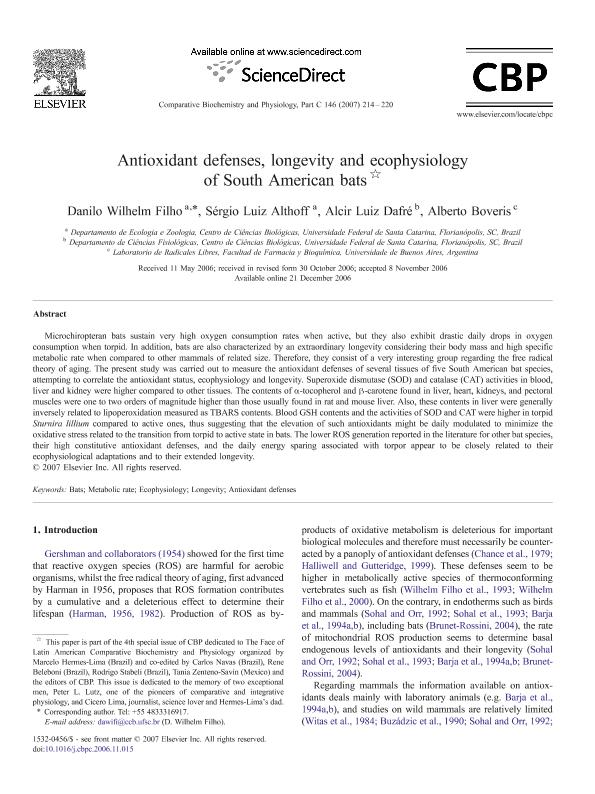Mostrar el registro sencillo del ítem
dc.contributor.author
Wilhelm Filho, Danilo
dc.contributor.author
Althoff, Sérgio Luiz
dc.contributor.author
Dafré, Alcir Luiz
dc.contributor.author
Boveris, Alberto Antonio

dc.date.available
2022-07-22T16:55:14Z
dc.date.issued
2007-12
dc.identifier.citation
Wilhelm Filho, Danilo; Althoff, Sérgio Luiz; Dafré, Alcir Luiz; Boveris, Alberto Antonio; Antioxidant defenses, longevity and ecophysiology of South American bats; Elsevier Science Inc.; Comparative Biochemistry And Physiology. Toxicology & Pharmacology; 146; 1-2 SPEC. ISS.; 12-2007; 214-220
dc.identifier.issn
1532-0456
dc.identifier.uri
http://hdl.handle.net/11336/162931
dc.description.abstract
Microchiropteran bats sustain very high oxygen consumption rates when active, but they also exhibit drastic daily drops in oxygen consumption when torpid. In addition, bats are also characterized by an extraordinary longevity considering their body mass and high specific metabolic rate when compared to other mammals of related size. Therefore, they consist of a very interesting group regarding the free radical theory of aging. The present study was carried out to measure the antioxidant defenses of several tissues of five South American bat species, attempting to correlate the antioxidant status, ecophysiology and longevity. Superoxide dismutase (SOD) and catalase (CAT) activities in blood, liver and kidney were higher compared to other tissues. The contents of alpha-tocopherol and beta-carotene found in liver, heart, kidneys, and pectoral muscles were one to two orders of magnitude higher than those usually found in rat and mouse liver. Also, these contents in liver were generally inversely related to lipoperoxidation measured as TBARS contents. Blood GSH contents and the activities of SOD and CAT were higher in torpid Sturnira lillium compared to active ones, thus suggesting that the elevation of such antioxidants might be daily modulated to minimize the oxidative stress related to the transition from torpid to active state in bats. The lower ROS generation reported in the literature for other bat species, their high constitutive antioxidant defenses, and the daily energy sparing associated with torpor appear to be closely related to their ecophysiological adaptations and to their extended longevity.
dc.format
application/pdf
dc.language.iso
eng
dc.publisher
Elsevier Science Inc.

dc.rights
info:eu-repo/semantics/openAccess
dc.rights.uri
https://creativecommons.org/licenses/by-nc-sa/2.5/ar/
dc.subject
ANTIOXIDANT DEFENSES
dc.subject
BATS
dc.subject
ECOPHYSIOLOGY
dc.subject
LONGEVITY
dc.subject
METABOLIC RATE
dc.subject.classification
Bioquímica y Biología Molecular

dc.subject.classification
Ciencias Biológicas

dc.subject.classification
CIENCIAS NATURALES Y EXACTAS

dc.title
Antioxidant defenses, longevity and ecophysiology of South American bats
dc.type
info:eu-repo/semantics/article
dc.type
info:ar-repo/semantics/artículo
dc.type
info:eu-repo/semantics/publishedVersion
dc.date.updated
2022-07-15T15:24:52Z
dc.journal.volume
146
dc.journal.number
1-2 SPEC. ISS.
dc.journal.pagination
214-220
dc.journal.pais
Estados Unidos

dc.description.fil
Fil: Wilhelm Filho, Danilo. Universidade Federal de Santa Catarina; Brasil
dc.description.fil
Fil: Althoff, Sérgio Luiz. Universidade Federal de Santa Catarina; Brasil
dc.description.fil
Fil: Dafré, Alcir Luiz. Universidade Federal de Santa Catarina; Brasil
dc.description.fil
Fil: Boveris, Alberto Antonio. Consejo Nacional de Investigaciones Científicas y Técnicas; Argentina
dc.journal.title
Comparative Biochemistry And Physiology. Toxicology & Pharmacology

dc.relation.alternativeid
info:eu-repo/semantics/altIdentifier/url/https://www.sciencedirect.com/science/article/abs/pii/S153204560600278X
dc.relation.alternativeid
info:eu-repo/semantics/altIdentifier/doi/http://dx.doi.org/10.1016/j.cbpc.2006.11.015
Archivos asociados
